Suspension Therapy
What is Suspension Therapy?
Suspension therapy offers a wide range of exercises that target strength, stability, flexibility, and balance. By adjusting the position of the straps and body angles, you can modify the intensity of the exercises to suit your fitness level.
Suspension therapy helps a person to improve their range of motion (ROM), improve muscle strength, and reinforce body domains by utilizing ropes and slings.
Suspension liberates the body from the conflict of fabric on which the body parts may be relaxing and it lets unrestricted motion without resistance. Late Mrs. Guthrie Smith originated the suspension device.
What are the Principles of Suspension Therapy?
It is working under the following principles:
- Friction
- Pendulum
- Eliminating gravity movement
Friction:
It happens when a certain texture moves on another texture. In suspension therapy, a therapist will utilize surfaces that are more soft and slippery so has more nominal friction generating smooth and easy motion.
Pendulum:
In the Pendulum weighty fabric is suspended by the lightweight thread if the danger is used to the pendulum resulting in free movement. One full swing is named oscillation.
While oscillating, the arc of motion of the pendulum assembles a component of the bottom of the cone. The oscillation will persist until the power comes down. The oscillation space comes low gradually with the resistance of the air and friction.
A muscle contraction is required to start the oscillation. Some mechanism is operated for suspension therapy to preserve the property of muscle, improve the range of movement (ROM), and strengthen the muscles.
Eliminating gravity movement:
If the individual has a muscle strength grade 2 is indicated for suspension training. If the muscle strength is lower than grade 2, It’s challenging to accomplish the suspension therapy training by the person himself. The individual should have minimal muscle contraction strength of grade 2 to accomplish suspension therapy activities.
If the muscle strength is above grade 3, the person can go for the against-gravity activity rather than suspension therapy.
What are the Parts of Suspension Therapy?
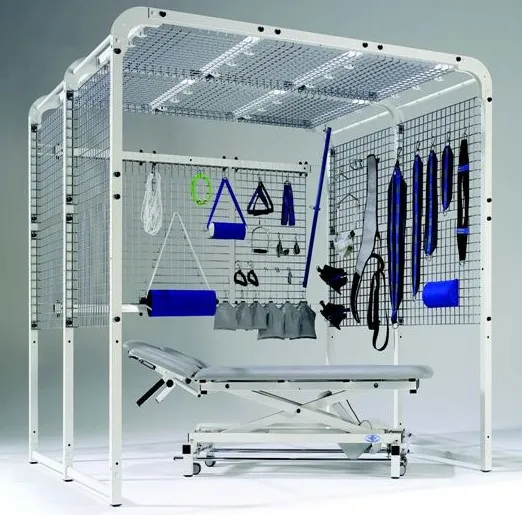
- Fixed point: suspension frame
- Pulley:
- Supporting ropes:
- Single rope
- Double rope
- Pulley rope
- Sling:
- Single sling
- Double sling
- Three-ring sling
- Head sling
- Wooden cleat:
- Dog clip, S hook:
Suspension frame:
- It is constructed of stainless steel/plastic-coated steel.
- The ceiling and head-end side show the 5cm metal mesh and the remaining sides are held open.
Pulley:
It provides a mechanical advantage. Pulleys are utilized to lessen the load of lifting the entire body/body regions. Sometimes single/double pulleys are operated relying on the condition. If the body portion is oversized. For example, in the trunk, thorax, and thigh, double pulleys are utilized.
Supporting rope:
There are three kinds of supporting ropes utilized for the suspension to avoid dropping.
- Single rope
- Pulley rope
- Double rope
Single rope
- It has a round settled at one end by which it is hinged up.
- The other end of the rope passes via one end of the wooden cleat via the circle of a dog clip and the further end of the cleat and then knotted.
Pulley rope
- This has a dog clip connected at one ending of the rope which then passes over the spin of a pulley.
- The rope then passes via the cleat & second dog clip.
Double rope
- Consists of two pulleys at the upper & more inferior attachments.
- So here there is a computerized benefit of 2.
Slings
There are four types of functional slings:
- Single sling
- Double sling
- Three-ring sling
- Head sling
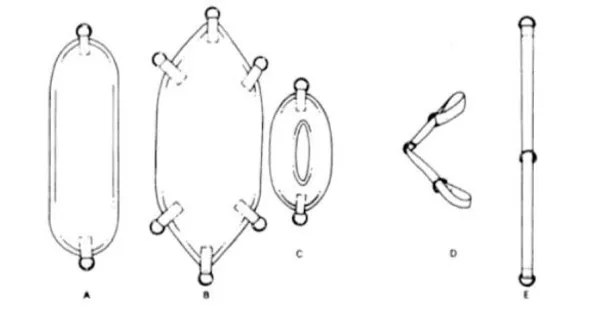
Single sling
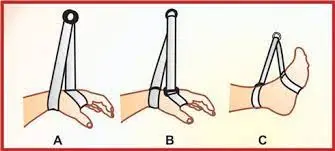
- Constructed of canvas wrapped with smooth webbing and with a D circle ring at both ends.
- Size: 68cm length & 17cm width.
- Operated for elbow and knee joint motion
- Occasionally tucked in the figure of eight methods to sustain the wrist and ankle.
Double sling
- Larger than a single sling
- It’ll have more than two sides with the D circle rings.
- Operated to reinforce larger portions for example the thorax, trunk, and thigh.
- Size: 68cm length & 29cm width.
Three-ring sling
- Size: 75cm length & 3-4cm width, including three-D circle rings.
- Two D circle rings at each ending of the sling and one in the center preserved forcing.
- Operated for wrist and ankle region motion.
Head sling
- This is a brief, divided sling with it is two halves sewed concurrently at an arc to construct a halfway slit.
- It is operated for head support in the center of the sling and shows a slit for the accommodation of the occipital area during supine and lower ear accommodation during side-lying.
Wooden cleat
- It is assembled of wood and utilized for modifying the rope length.
- It has two/three gaps for the rope passage.
- The rope itself carries the cleat by friction resistance.
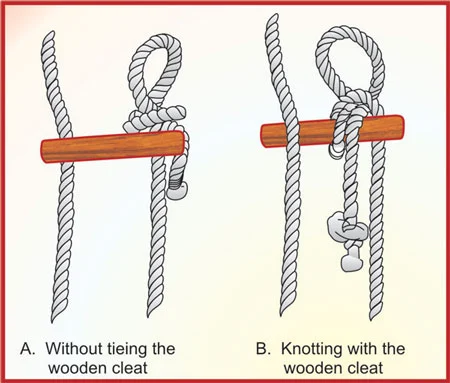
Dog clip/S hook
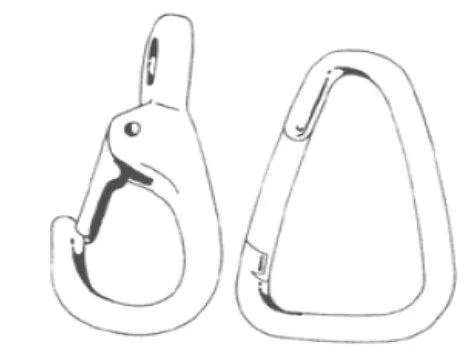
- Utilized to connect the supportive rope with the suspension frame.
- Secure the sling with a supportive rope.
What are the Types of Suspension Therapy?
- Axial suspension
- Vertical suspension
- Pendular suspension
Axial suspension
- The joint axis is assumed as the pinpoint of the suspension.
- The slings beyond the axis of the joint to support the extremity.
- If the activity is started the extremity is dragged on each side.
- The component moves parallel to the ground.
Uses of axial suspension:
- Relaxation
- Sustain muscular property
- To boost the blood circulation
- Improve the venous drainage
- Improve the lymphatic drainage
Vertical suspension
- The center of gravity (COG) of the body region/body is assumed as a point of suspension.
- Operated to deliver reinforcement to the body region of the patients.
Uses of vertical suspension:
- To sustain the body portion
- To decrease the pressure sore.
Pendular suspension
- The point of suspension should be moved out from the joint axis.
- Activity generally brings place against gravity.
- Muscles will be obtaining resistance during movement if the axis is moved to oppose that motion.
Uses of pendular suspension
- To strengthen the muscle.
- To raise the muscle power
- Improve endurance.
Advantages of Suspension Therapy
- It lessens the load on the physiotherapist.
- Comfortable lifting the extremity.
- Active motion can be accomplished effortlessly with the lowest friction.
- More comfortable to carry the position of the extremity with slings and pulleys in the needed position.
Disadvantage of Suspension Therapy
- Especially complex and not always the first option for beginners in resistance exercise.
- Needed a lot of materials for example slings, ropes, and pulleys.
Indications of Suspension Therapy
- Spinal cord injuries.
- Hemiplegia.
- Post-operative muscle weakness.
Contraindications of Suspension Therapy
- Head injury
- Fracture
- Spinal cord injury
- Circulatory disorder etc.
The Technique of Suspension Therapy
Shoulder Abduction and Adduction:
Muscles name:
- Abductor: 0-15 degrees:- Supraspinatus, 15-90 degrees:- Medial Deltoid, 90-180 degrees:- Trapezius and serratus anterior.
- Adductor: Pectoralis major, Latissimus dorsi, and Teres major.
Position of the patient: Supine lying position.
Point of suspension: One inch below the acromion process of the scapula.
Accessories required:
- S-hooks: 3
- Three-ring sling: 1
- Single sling: 1
- Supporting rope with wooden clit: 2
Procedure:
- One inch below the acromion process of the scapula is assumed as the suspension point by the primary supportive rope which is secured by the s-hook with the suspension frame.
- A secondary supporting rope is connected in the same s-hook.
- Three-ring sling is operated to sustain the wrist.
- A single sling is operated to reinforce the elbow.
- The primary supporting rope is connected to the wrist sling.
- A secondary supporting rope is connected to the elbow sling.
- The patient is recommended to execute the abduction and adduction activity of the shoulder.
- For intensifying the abductor medial motion of the axis is taken out, and vice versa for adductor intensifying.

Shoulder Flexion and Extension
Muscles name:
- Flexor- Anterior deltoid, pectoralis major, and coracobrachialis.
- Extensor- Latissimus dorsi, teres major and minor, and posterior deltoid muscles.
Position of patient– Side-lying.
Point of suspension: Greater tuberosity
Accessories required:
- S-hooks: 3
- Three-ring sling: 1
- Single sling: 1
- Supporting rope with wooden cleat: 2
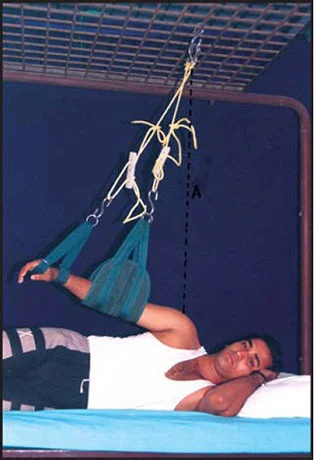
Procedure:
- Greater tuberosity is assumed as the suspension point by connecting the supporting rope. Which is hooked by the s-hook with the suspension frame.
- A secondary supporting rope is secured in the same s-hook.
- Three-ring sling is operated to support the wrist.
- A single sling is utilized to sustain the elbow.
- The primary supporting rope is connected to the wrist sling.
- A secondary supporting rope is hooked to the elbow sling.
- The patient is recommended to execute the flexion and extension motion of the shoulder.
- For reinforcing the power of the flexor posterior motion of the axis is accepted out and vice versa for extensor strengthening.
Shoulder Medial and Lateral Rotation
Muscles name:
- Medial Rotation: Anterior Deltoid, Subscapulais, latissmus dorsi, Teres major.
- Lateral Rotation: Posterior Deltoid, Infraspinatus, Teres minor
Position of the patient: Supine lying.
Point of suspension: Olecranon process.
Accessories required:
- S-hook: 4
- Three-ring sling: 1
- Single sling: 1
- Supporting rope with wooden cleat: 2
Procedure:
- The shoulder is bent 90° with the elbow in 90° flexion the olecranon process is assumed as the suspension point by a primary supporting rope which is secured by the s-hook with the suspension frame.
- The secondary rope is connected with the head side suspension frame by another s-hook in the vertical suspension.
- Three-ring sling is operated to reinforce the wrist.
- A single sling is utilized to keep the arm.
- The primary supporting rope is connected to the wrist sling.
- A secondary supporting rope is connected to the arm sling.
- The patient is ordered to execute the medial and lateral rotation action of the shoulder.
- For intensifying the medial rotator, lateral shifting of the axis is dragged out, and vice versa for lateral rotator strengthening.
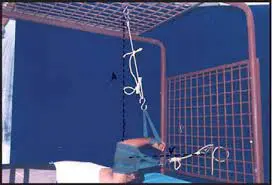
Elbow Flexor and Extensor
Muscle name:
- Flexor: Biceps brachii, Brachioradialis, and Brachialis.
- Extensor: Anconeus and Triceps brachii.
Position of the patient: Sitting.
Point of suspension: Lateral epicondyle of the humerus bone.
Accessories required:
- S-hooks: 4
- Three-ring sling: 1
- Single sling: 1
- Supporting rope with wooden cleat: 2

Procedure:
- The shoulder is abducted at 90 degrees with the elbow in a 90 degrees flexed position the lateral epicondyle is assumed as the suspension point by the primary supporting rope, which is secured by the s-hook with the suspension frame.
- The secondary supporting rope is connected with the suspension frame by another s-hook in vertical suspension.
- Three-ring sling is utilized to reinforce the wrist.
- A single sling is utilized to keep the arm.
- The primary supporting rope is connected to the wrist sling.
- A secondary supporting rope is connected to the arm sling.
- The patient is guided to execute the elbow flexion and extension motion.
- For boosting the strength of the flexor lateral shifting of the axis is dragged out and vice versa for extensor strengthening.
Hip Flexion and Extension
Muscle name:
- Flexion: Iliopsoas, Rectus femoris, Pectineus, Sartorius, and Tensor fascia lata.
- Extension: Gluteus maximus, Biceps femoris, Semimembranosus, and Semitendinosus muscles.
Position of the patient: Side-lying.
Point of suspension: Greater trochanter of the femur.
Accessories required:
- S-hooks: 3
- Three-ring sling: 1
- Single sling: 1
- Supporting rope with wooden cleat: 2
Procedure:
- The greater trochanter is assumed as the suspension point by a primary supporting rope which is secured by the s-hook with the suspension frame.
- A secondary supporting rope is connected with the same s-hook.
- A single sling is utilized to support the knee.
- Three-ring sling is utilized to support the ankle.
- The primary supporting rope is connected to the ankle sling.
- A secondary supporting rope is connected to the knee sling.
- The patient is guided to execute the flexion and extension motion of the hip.
- For boosting the strength of the flexor posterior shifting of the axis is carried out and vice versa for extensor strengthening.
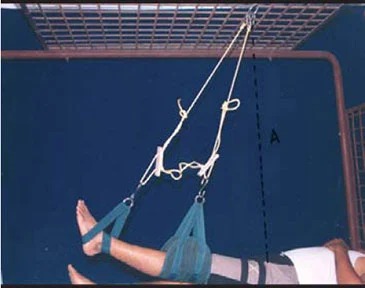
Hip Abductor and Adductor
Muscles name:
- Abductor: Gluteus medius and Gluteus minimus
- Adductor: Adductor longus, Adductor magnus, and Adductor brevis muscles
Position of a patient: Supine lying with contrasting hip abducting to its full limit.
Point of suspension: 2 inches below the anterior superior iliac spine (ASIS)
Accessories required:
- S-hooks: 3
- Three-ring sling: 1
- Single sling: 1
- Supporting rope with wooden cleat: 2

Procedure:
- Two inches below the anterior superior iliac spine (ASIS) is accepted as the suspension point by the primary supporting rope which is secured by the s-hook with the suspension frame.
- A secondary supporting rope is connected with the same s-hook.
- Three-ring sling is utilized to reinforce the foot and ankle.
- A single sling is utilized to support the knee.
- The primary supporting rope is connected to the ankle sling.
- The secondary supporting rope is connected to the knee sling.
- The patient is guided to execute the abduction and adduction action of the hip.
- To improve the strength of the abductor medial shifting of the axis is dragged out and vice versa for adductor strengthening.
Hip Medial and Lateral Rotation
Muscle name:
- Medial Rotator: Gluteus minimus and Tensor fascia lata.
- Lateral Rotator: Gluteus maximus, Piriformis, Superior gemellus, Inferior gemellus, Obturator enternus, and Obturator externus,
Position of the patient: Supine lying.
Point of suspension: Apex of the patella bone.
Accessories required:
- S-hooks: 4
- Three-ring sling: 1
- Single sling: 1
- Supporting rope with wooden cleat: 2
Procedure:
- The apex of the patella is accepted as the suspension point by the primary supporting rope, which is secured by the s-hook with the suspension frame.
- The secondary supporting rope is connected with the head side suspension frame by another s-hook.
- Three-ring sling is utilized to keep the ankle.
- A single sling is utilized to keep the thigh.
- The primary supporting rope is connected to the ankle sling.
- A secondary supporting rope is connected to the thigh sling.
- The patient is guided to execute the medial and lateral action of the hip.
- To improve the strengthening of the medial rotator medial shifting of the axis is dragged out and vice versa for lateral rotator strengthening.
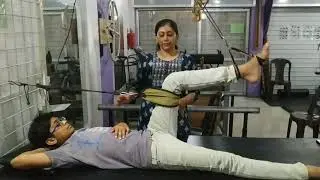
Knee Flexion and Extension
Position of the patient: Side-lying.
Point of suspension: Lateral joint line of the knee joint.
Accessories required:
- S-hooks: 4
- Three-ring sling: 1
- Single sling: 1
- Supporting rope with wooden cleat: 2
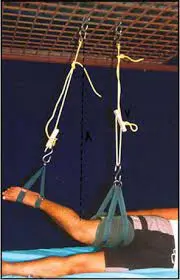
Procedure:
- The lateral joint line is accepted as the suspension point by the primary supporting rope, which is secured by the s-hook with the suspension frame.
- COG of the thigh is assumed as the suspension point by the secondary supporting rope. Which is connected to the head side suspension by another s-hook in vertical suspension.
- Three-ring sling is utilized to reinforce the ankle.
- A single sling is utilized to support the thigh.
- The primary supporting rope is connected to the ankle sling.
- A secondary supporting rope is connected to the thigh sling.
- The patient is guided to execute the flexion and extension action of the knee.
- To improve the strength of the flexor posterior shifting of the axis is dragged out and vice versa for extensor strengthening.
For Whole Body Suspension

- The individual slings are suspending each limb in the vertical suspension with reinforcing ropes. The upper trunk, lower trunk, head, and both upper extremities and lower extremities are balanced with separate supporting ropes in the vertical suspension to set the entire body suspension.
FAQ
Why use suspension therapy?
Because of the way suspension exercise tools leverage gravity and the body weight of individuals against body arch, body stability, and body momentum (pendulum impact) to promote different activities to develop strength, balance, mobility, and core stability simultaneously and support damage deterence and restoration.
What is the principle of suspension therapy?
Suspension mainly works on the following 3 principles:
Friction
Gravity eliminating
Pendulum
Who invented suspension therapy?
Guthrie Smith developed the suspension device. Which is constructed of wood and is utilized for varying the rope. It consists of two/three gaps for the rope route.
What are the health benefits of suspension?
Provide relaxation
Enhances core strength.
Constructs functional strength, agility, and power.
Portable easy to set up.
Can adapt to different fitness levels.
What instruments are used in suspension therapy?
Suspension therapy is the usage of ropes, pulleys, and slings to permit frictionless action to grow a range of motion (ROM), and muscle strength, and to reinforce body regions.
Fixed point: suspension frame
Pulley:
Supporting ropes:
Single rope, Double rope, Pulley rope
Sling:
Single Double and Three-ring sling, Head sling
Wooden cleat:
Dog clip, S hook:

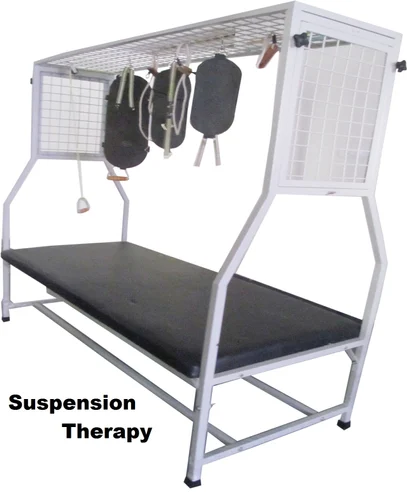
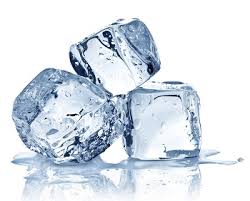

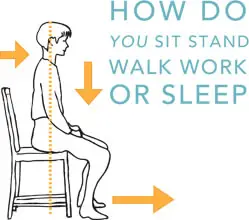
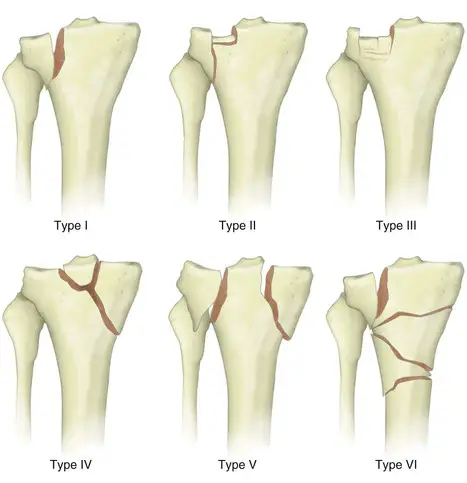

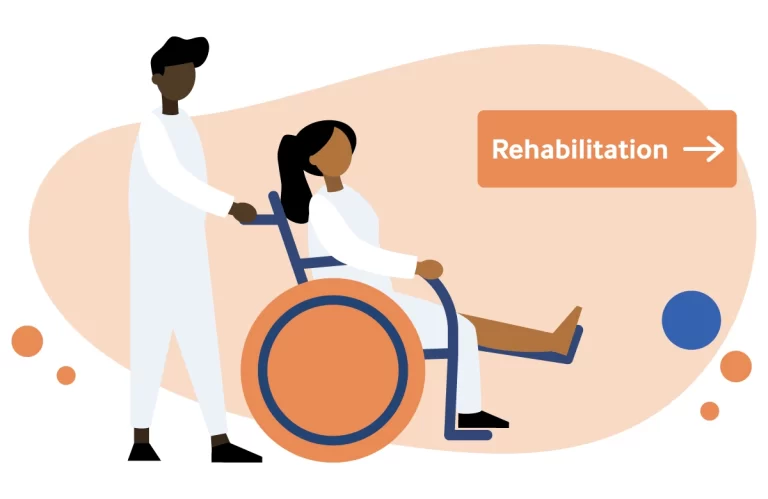
7 Comments